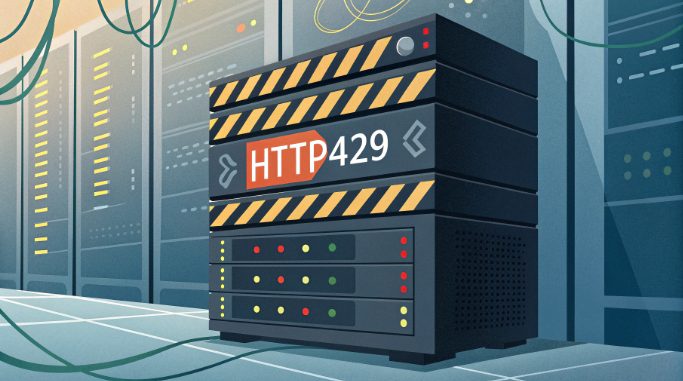Reasons for Server HTTP 429 Errors and Solutions

Understanding and effectively managing HTTP 429 “Too Many Requests” errors is crucial for maintaining robust server operations and API reliability. This comprehensive guide delves into the technical intricacies of rate limiting, exploring both the root causes and advanced solutions for handling these server-side challenges.
Understanding HTTP 429: Beyond the Basics
HTTP 429 status code represents a response sent by servers when a client has exceeded the allowed number of requests within a specific timeframe. Unlike common 4xx errors, this response specifically indicates rate limiting violations, making it a critical metric for API governance and server resource management.
Common Triggers of 429 Responses
- Aggressive API polling without proper intervals
- Distributed denial-of-service (DDoS) patterns
- Misconfigured client-side request loops
- Inadequate API throttling implementations
- Concurrent connection overflow
Technical Deep Dive: Rate Limiting Mechanisms
Rate limiting implementations typically utilize sophisticated algorithms to track and manage request frequencies. Let’s examine the most effective approaches:
- Token Bucket Algorithm
bucket_capacity = 100
refill_rate = 10 // tokens per second
current_tokens = min(bucket_capacity, current_tokens + elapsed_time * refill_rate)
- Leaky Bucket Algorithm
queue_size = 100
processing_rate = 10 // requests per second
- Fixed Window Counters
- Sliding Window Logs
Advanced Diagnostic Approaches
When encountering 429 errors, systematic diagnosis is crucial. Here’s a structured approach to troubleshooting:
- Server Log Analysis
- Request timestamps
- IP distribution patterns
- Response time metrics
- Resource utilization stats
- Network Traffic Inspection
- Packet analysis
- Request header examination
- Rate limiting headers verification
- Client-Side Monitoring
- Request queuing status
- Retry mechanism effectiveness
- Connection pooling metrics
Implementation of Preventive Measures
Effective prevention requires a multi-layered approach incorporating both infrastructure and code-level solutions:
- Infrastructure Level:
# Nginx Rate Limiting Configuration
limit_req_zone $binary_remote_addr zone=one:10m rate=1r/s;
limit_req zone=one burst=5 nodelay;
- Application Level:
const rateLimit = {
windowMs: 15 * 60 * 1000, // 15 minutes
max: 100 // limit each IP to 100 requests per windowMs
};
Enterprise-Grade Solution Architecture
For high-availability systems, implementing a comprehensive rate limiting strategy requires sophisticated architectural considerations:
- Distributed Rate Limiting
// Redis-based distributed rate limiter
function checkRateLimit(userId) {
const key = `ratelimit:${userId}`;
const limit = 100;
const window = 3600; // 1 hour in secondsreturn redis.multi()
.incr(key)
.expire(key, window)
.exec();
} - Load Balancer Configuration
# HAProxy rate limiting
stick-table type ip size 100k expire 30s store http_req_rate(10s)
http-request track-sc0 src
http-request deny deny_status 429 if { sc_http_req_rate(0) gt 100 }
Advanced Error Handling Patterns
Implementing robust error handling requires sophisticated retry mechanisms and backoff strategies:
- Exponential Backoff Implementation:
async function retryWithBackoff(operation, retries = 3) {
for (let i = 0; i < retries; i++) { try { return await operation(); } catch (err) { if (err.status !== 429) throw err; const delay = Math.pow(2, i) * 1000; await new Promise(resolve => setTimeout(resolve, delay));
}
}
throw new Error('Max retries reached');
}
- Circuit Breaker Pattern:
class CircuitBreaker {
constructor(failureThreshold = 5, resetTimeout = 60000) {
this.failureCount = 0;
this.failureThreshold = failureThreshold;
this.resetTimeout = resetTimeout;
this.state = 'CLOSED';
}
}
Monitoring and Analytics Integration
Implementing comprehensive monitoring solutions is crucial for proactive rate limit management:
- Metrics to Track:
- Request rate per endpoint
- 429 error frequency
- Average response time
- Resource utilization
- Alert Thresholds:
// Alert configuration example
{
"429_error_rate": {
"threshold": "5%",
"window": "5m",
"action": "notify_ops"
}
}
Best Practices and Industry Standards
When implementing rate limiting strategies, adhering to industry best practices ensures optimal system performance:
- HTTP Header Implementation
X-RateLimit-Limit: 100
X-RateLimit-Remaining: 75
X-RateLimit-Reset: 1640995200
Retry-After: 3600
- API Documentation Standards
// OpenAPI specification example
{
"responses": {
"429": {
"description": "Too Many Requests",
"headers": {
"Retry-After": {
"schema": {
"type": "integer"
}
}
}
}
}
}
Frequently Asked Technical Questions
- Q: How does rate limiting differ in microservices architecture?
A: Microservices require distributed rate limiting strategies, often implementing consistent hashing and shared state management across services.
- Q: What’s the optimal rate limit for REST APIs?
A: Depends on infrastructure capacity, but typical starting points are 1000-3000 requests per hour for authenticated endpoints, with burst allowances.
- Q: How to handle rate limiting in serverless environments?
A: Implement token bucket algorithms using distributed caches (Redis/DynamoDB) and configure concurrent execution limits.
Future-Proofing Your Rate Limiting Strategy
Consider these emerging trends and technologies for long-term rate limiting solutions:
- AI-powered rate limiting adaptation
- Context-aware throttling mechanisms
- Quantum-resistant rate limiting algorithms
- Edge computing rate limiting implementation
Conclusion and Key Takeaways
Managing HTTP 429 errors effectively requires a comprehensive understanding of rate limiting mechanisms, proper implementation of monitoring systems, and adoption of industry best practices. By implementing the technical solutions and strategies outlined in this guide, developers and system administrators can better handle rate limiting challenges while maintaining optimal API performance and reliability.
Remember to regularly review and update your rate limiting strategies as your system scales and evolves. Stay informed about the latest developments in API management and rate limiting technologies to ensure your infrastructure remains robust and efficient in handling HTTP 429 errors.

